Extreme weather events have slowed economic growth, adding to the case for another rate cut
- Written by Stella Huangfu, Associate Professor, School of Economics, University of Sydney

Australia’s economy slowed sharply in the March quarter, growing by just 0.2% as government spending slowed and extreme weather events dampened demand. That followed an increase of 0.6% in the previous quarter.
The national accounts report[1] from the Australian Bureau of Statistics (ABS) showed annual growth steady at 1.3%, below market forecasts for an improvement to 1.5%.
The result is also weaker than the Reserve Bank of Australia’s forecasts.
The ABS said: “Extreme weather events further dampened domestic demand and reduced exports”, with the impact particularly evident in mining, tourism and shipping.
This report on Gross Domestic Product (GDP) will be a key consideration for the Reserve Bank’s next meeting on July 7–8, helping shape its decision on whether to cut rates again. In May, the central bank cut the cash rate[2] by 0.25% to 3.85%.
On balance, the softer than expected pace of growth makes another rate cut in July a bit more likely.
Private demand drives growth as public spending slumps
Household spending slowed to 0.4% in the quarter from 0.7%. Essential spending led the way, with a sharp 10.2% rise in electricity costs due to a warmer-than-usual summer and reduced electricity bill rebates. Food spending also increased as Queenslanders stocked up ahead of Tropical Cyclone Alfred.
Investment also contributed to growth, though its composition shifted. Private investment rose 0.7%, driven by a rebound in house building and strong non-dwelling construction, particularly in mining and electricity projects. But business investment in equipment and machinery slumped.
Public investment fell 2.0%, ending a run of positive growth since September 2024. This decline, which detracted 0.1 percentage points from GDP, reflected the completion or delay of energy, rail and road projects.
“Public spending recorded the largest detraction from growth since the September quarter 2017”, the ABS said.
Disappointing trade performance
Exports unexpectedly became the main drag on growth in the March quarter, marking a sharp turnaround from December 2024.
Total exports fell 0.8%, led by a drop in services – particularly travel – due to weaker foreign student arrivals and lower spending. Goods exports also declined as bad weather disrupted coal and natural gas shipments, and demand from key markets like China and Japan softened.
The growth outlook is soft
Given the weaker-than-expected growth in the March quarter, Australia’s economic outlook remains soft.
A disappointing sign in the report was another fall in GDP per head of population, known as GDP per capita. This measure declined by 0.2%, after just one quarterly rise and seven previous quarters of a “per capita recession[3]”, when population growth outpaces economic growth.
The household saving rate continue to rise in the March quarter, back to pre-COVID levels at 5.2%. This is because income grew faster than spending, and households remain cautious amid economic uncertainty. Additional government support also boosted savings.
The economic slowdown reflects weak household spending and a notable pullback in public sector investment. With domestic demand under strain, short-term growth prospects appear limited as the economy continues to adjust to past interest rate hikes and the early effects of the recent cuts.
The Reserve Bank began cutting official rates in February – its first move after 13 consecutive hikes between May 2022 and November 2023 – but the impact has yet to flow through. The next GDP figures, due on September 3, will offer a clearer picture of how the February and May rate cuts are shaping the recovery.
Trade tensions add uncertainty
Global conditions have become more unsettled, with rising trade tensions[4] and shifting geopolitical alliances putting pressure on international trade. Renewed tariff threats – particularly from the US[5] – are disrupting global supply chains. For export-reliant Australia, this increases the risk of weaker trade volumes and greater exposure to external shocks.
At the same time, China’s post-pandemic recovery is losing momentum[6], dragged down by weak consumer demand and a struggling property sector.
Given Australia’s close trade ties with China, any sustained slowdown there poses a clear threat to export earnings and broader economic growth. Together, these global headwinds are adding to the uncertainty surrounding Australia’s economic outlook.
A balancing act on rates
With demand soft and the economy losing momentum, the Reserve Bank may cut interest rates again at its July meeting to help boost growth. Key sectors like household spending, public services and mining have been under pressure. A further rate cut could support confidence and encourage more spending.
However, the monthly inflation report for April[7] adds uncertainty. While headline inflation held steady at 2.4% over the year to April, underlying measures ticked higher. The monthly rate excluding volatile items such as fuel and fresh food rose to 2.8%, up from 2.6%. That suggests price pressures are becoming more widespread.
These mixed signals leave the RBA facing a delicate balancing act. Upcoming data, particularly the employment report on June 19 and the May monthly inflation indicator on June 25, will be critical in determining whether inflation is easing enough to justify another cut or showing signs of persistence that call for caution.
References
- ^ national accounts report (www.abs.gov.au)
- ^ cut the cash rate (www.rba.gov.au)
- ^ per capita recession (www.aicd.com.au)
- ^ rising trade tensions (theconversation.com)
- ^ from the US (www.theguardian.com)
- ^ China’s post-pandemic recovery is losing momentum (theconversation.com)
- ^ inflation report for April (www.abs.gov.au)




















